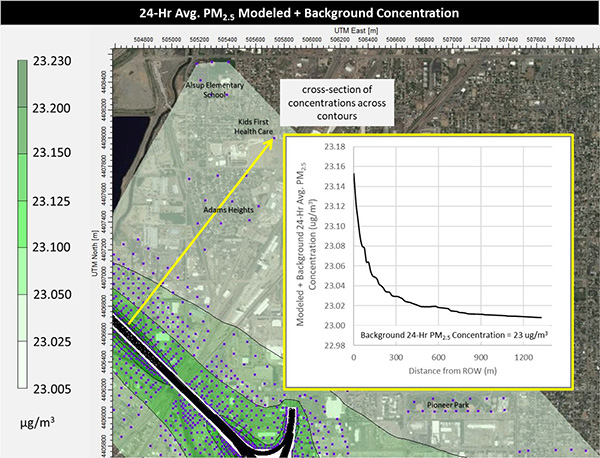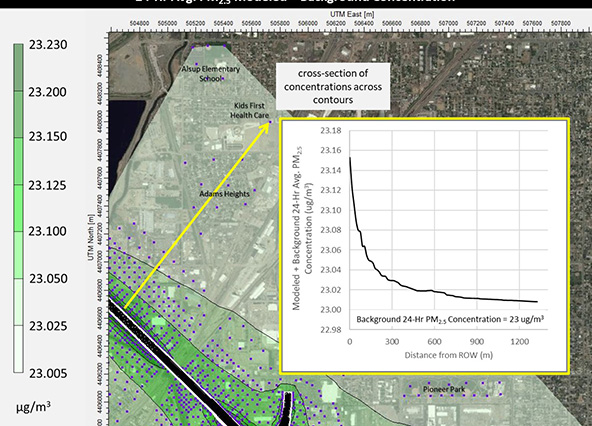Air Quality and GHG Support for the State of Colorado
Clients
Colorado Department of Transportation (CDOT)
Sonoma Technology has worked with CDOT staff over many years to provide air quality support related to transportation projects. Colorado was one of seven state DOTs that, in collaboration with the U.S. Federal Highway Administration (FHWA), funded Sonoma Technology’s work under a <a href="https://www.sonomatech.com/projects/4431">multi-year Near-Road Air Quality Transportation Pooled Fund program</a href>.<br>
Sonoma Technology provides ongoing air quality support to CDOT as a subcontracting partner on several CDOT environmental service contracts. An example of our work involves particulate matter (PM) emissions and air quality modeling for the CDOT Interstate 270 (I-270) Corridor Improvements project. For an overview of the I-270 project, see the CDOT presentation <a href="https://www.youtube.com/watch?v=SkQi8KuWmzI" target="_blank">available at this webinar link</a href>. Government stakeholders for the I-270 improvement project include CDOT, FHWA, and officials in Adams County and Commerce City, Colorado.<br>
To assess the proposed I-270 improvements, Sonoma Technology conducted air quality dispersion modeling and completed a PM hot-spot analysis. We completed PM<sub>2.5</sub> and PM<sub>10</sub> air quality modeling based on the requirements of (1) the National Environmental Policy Act (NEPA), (2) U.S. EPA guidance for roadway hot-spot analyses, (3) Colorado Revised Statutes (CRS) Section 43-1-128, and (4) CDOT Air Quality Project-Level Analysis Guidance (AQ-PLAG). Our PM analysis work was informed by EPA’s “Transportation Conformity Guidance for Quantitative Hot-spot Analyses in PM<sub>2.5</sub> and PM<sub>10</sub> Nonattainment and Maintenance Areas.” The analysis was designed to help CDOT address public comments. Therefore, our approach went beyond typical PM hot-spot analyses and assessed PM concentrations at (1) sensitive locations farther than 500 meters from the project, and (2) on public trails within the CDOT right-of-way (ROW). The air quality analysis Sonoma Technology completed is available from CDOT at <a href="https://www.codot.gov/projects/i270/project-documents-and-reports" target="_blank">https://www.codot.gov/projects/i270/project-documents-and-reports</a href>; scroll to ‘Air Quality Report’ (our work is included in a Jacobs Engineering pdf file).”<br>
Sonoma Technology is also helping CDOT address climate change and greenhouse gas (GHG) concerns. For the I-270 project, our assessment includes estimating cumulative GHG emissions over the lifetime of the project. The analysis is motivated by Colorado state legislation (CRS 43-1-128) which, effective July 2022, mandated that CDOT and metropolitan planning organizations (MPOs) account for impacts on statewide GHG emissions and vehicle miles traveled when planning for regionally significant transportation projects. Sonoma Technology’s GHG assessment includes use of the FHWA Infrastructure Carbon Estimator (ICE) tool to estimate emissions associated with construction and maintenance activities.
Sonoma Technology provides ongoing air quality support to CDOT as a subcontracting partner on several CDOT environmental service contracts. An example of our work involves particulate matter (PM) emissions and air quality modeling for the CDOT Interstate 270 (I-270) Corridor Improvements project. For an overview of the I-270 project, see the CDOT presentation <a href="https://www.youtube.com/watch?v=SkQi8KuWmzI" target="_blank">available at this webinar link</a href>. Government stakeholders for the I-270 improvement project include CDOT, FHWA, and officials in Adams County and Commerce City, Colorado.<br>
To assess the proposed I-270 improvements, Sonoma Technology conducted air quality dispersion modeling and completed a PM hot-spot analysis. We completed PM<sub>2.5</sub> and PM<sub>10</sub> air quality modeling based on the requirements of (1) the National Environmental Policy Act (NEPA), (2) U.S. EPA guidance for roadway hot-spot analyses, (3) Colorado Revised Statutes (CRS) Section 43-1-128, and (4) CDOT Air Quality Project-Level Analysis Guidance (AQ-PLAG). Our PM analysis work was informed by EPA’s “Transportation Conformity Guidance for Quantitative Hot-spot Analyses in PM<sub>2.5</sub> and PM<sub>10</sub> Nonattainment and Maintenance Areas.” The analysis was designed to help CDOT address public comments. Therefore, our approach went beyond typical PM hot-spot analyses and assessed PM concentrations at (1) sensitive locations farther than 500 meters from the project, and (2) on public trails within the CDOT right-of-way (ROW). The air quality analysis Sonoma Technology completed is available from CDOT at <a href="https://www.codot.gov/projects/i270/project-documents-and-reports" target="_blank">https://www.codot.gov/projects/i270/project-documents-and-reports</a href>; scroll to ‘Air Quality Report’ (our work is included in a Jacobs Engineering pdf file).”<br>
Sonoma Technology is also helping CDOT address climate change and greenhouse gas (GHG) concerns. For the I-270 project, our assessment includes estimating cumulative GHG emissions over the lifetime of the project. The analysis is motivated by Colorado state legislation (CRS 43-1-128) which, effective July 2022, mandated that CDOT and metropolitan planning organizations (MPOs) account for impacts on statewide GHG emissions and vehicle miles traveled when planning for regionally significant transportation projects. Sonoma Technology’s GHG assessment includes use of the FHWA Infrastructure Carbon Estimator (ICE) tool to estimate emissions associated with construction and maintenance activities.
Air Quality
Climate
Emissions
Modeling
Transportation


Kenneth J. Craig

Kenneth
J.
Craig
Manager, Atmospheric and Emissions Modeling Group / Principal Scientist
kcraig@sonomatech.com
/sites/default/files/2023-02/KJCres.pdf
